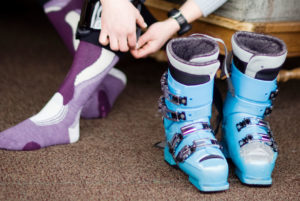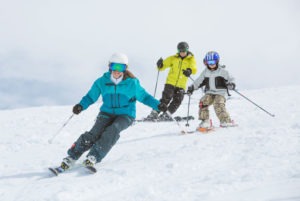Choosing Hiking Boots
One of the trickier aspects of hiking is choosing the right boots. With so many styles and types available, it can be difficult to figure out which boots will be best for you. Rather than solely relying on online reviews, it’s best to first break down hiking boots as a whole and decide what exactly you are looking for in a hiking boot, how often you’ll be hiking, where you’ll be hiking and dialing in your foot print (wide, narrow, high arch, etc.). Read on to educate yourself in finding the perfect hiking boot…
Types of Hiking Boots
- Light Hiking Shoes – Mostly for day hikes, light hiking shoes look more like a beefed up sneaker. They can be useful for longer hikes so long as you aren’t carrying a pack loaded with several days worth of gear. Light hiking shoes are also popular for everyday wear.
- Hiking Boots – Hiking boots are either mid or high cut. They are constructed of leather or man-made uppers and often have mesh panels for extra ventilation. Hiking boots can be worn for day hikes or weekend light backpacking trips.
- Backpacking Boots – Looking like a more traditional boot for hiking, backpacking boots are designed for hikes that will span multiple days. Backpacking boots are extremely popular and somewhat essential for long multi-day backpacking trips where the hiker will be carrying a heavy pack. With a heavy load on your back, you’ll need the shock absorbing soles and extra support found in backpacking boots for all day long comfort. Heavier than light hiking shoes or hiking boots, backpacking boots work well for hikes on or off designated trails.
- Mountaineering Boots – Also good for carrying heavier loads, mountaineering boots intentionally weigh more than the previous three types of boots. They work well with crampons, which are essential if you’ll be hiking in an icy area. They are the most durable type of hiking boot and also the least popular since most people aren’t backcountry hiking on the regular.
Low, Mid or High Cut Boots?
- Low Cut Shoes – For day hikes on well-maintained trails, low cut shoes are perfect. They fit more like a sneaker, so they won’t protect your ankles from trail debris. Low cut boots provide less roll resistance for ankles, but hikes with a light load, they’re perfect.
- Mid Cut Boots – These boots wrap low around the ankle and offer some cushioning and protection from debris, sand and mud. They best suited for day hikes, or short multi-day hikes with moderate loads.
- High Cut Boots – For people who carry heavy loads or steer off of maintained trails, high cut boots are key. They offer the best protection from debris, and drastically enhance balance and ankle support. They do require some breaking in, so it’s best to buy them and wear them before going on a hike.
Materials
The boot’s weight, breathability, durability and water resistance are directly affected by the materials used to upper portion of the boot also known as the ‘boot upper’ or ‘upper material.’ Different boot uppers can achieve the same or similar result, so preference is often the main factor when deciding on a boot upper. Let’s check out the various types of boot uppers….
- Full Grain Leather – Durable and supportive, full grain leather It is used in the construction of midweight backpacking or heavyweight mountaineering boots. It’s the best material for hikers who will be carrying bigger loads over unstable terrain. Full-grain leather footwear is heavier and less breathable than lightweight hiking footwear, but is generally more durable and provides more water protection. Be sure to break your full grain leather boots in before wearing!
- Nubuck Leather – Nubuck leather is a full-grain leather that has been sanded or buffed to resemble suede. It is very soft, durable, and resists water and abrasion. Like full grain leather, be sure to break in Nubuck before hitting the trail.
- Nylon, Mesh and Split Grain Leather – Such materials typically don’t need time to break in. They are breathable and lightweight making them great for summer day hikes. Synthetic materials are less expensive and perfect for newbies or those who won’t use them on a weekly basis, but they won’t provide as much water protection as full grain or nubuck leather.
Waterproof Protection
Waterproof barriers are built into many hiking boots and shoes to enhance water resistance. From lightweight hikers to heavyweight mountaineering boots, the performance of these waterproof barriers depends on the type of waterproof material used and how well you care for your boots or shoes.
- Waterproof Linings – Waterproof/breathable membranes such as Gore-Tex® or eVent® are often built into hiking shoes or boots to prevent moisture from passing from the outside materials through to your feet. The downside is that such boots are often a bit too warm for hot summer hikes.
- Waterproof Leather – Some leather is topically treated to resist moisture. However, if the boot is of poor quality with faulty seams, water will find it’s way into the boot. Check for lose threads on the seams. Also, if soaked for extended periods, the boots will eventually become very wet.
- Waterproof Construction – For extremely wet climates or multiple encounters with water obstacles on the trail, waterproof construction with seam sealing or specialized stitching is beneficial to keep your feet dry. Such construction is usually combined with topical waterproof treatments for maximum moisture resistance.
Dial In a Perfect Fit
The most important factor to consider when buying hiking boots is how they fit. You should have room inside of the boot to wiggle your toes easily. The boots should not be so wide that your feet slide around, nor should they be so loose that your feet slip inside of them. You should not have any heel lift when walking. This is why it’s especially important for women to stick to women’s specific hiking shoes.
When trying on hiking boots, you should wear the socks that you would be wearing while hiking so that you can get a feel for how the boots will actually fit you. You should also lace them however you would lace your boots while hiking, and take some time to walk through your house so that you get a good idea of what the boots will feel like as you are hiking.
There you have it! Now you’re set with the most important basic knowledge of how to choose the best hiking boots for your feet. Check out The House’s selection of men’s and women’s hiking boots!









